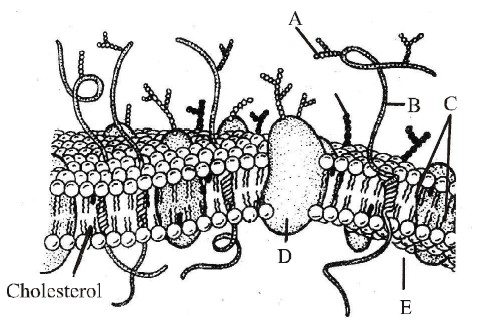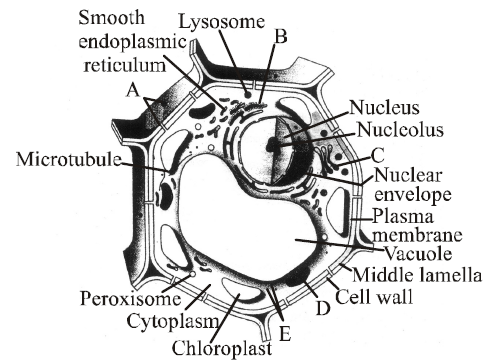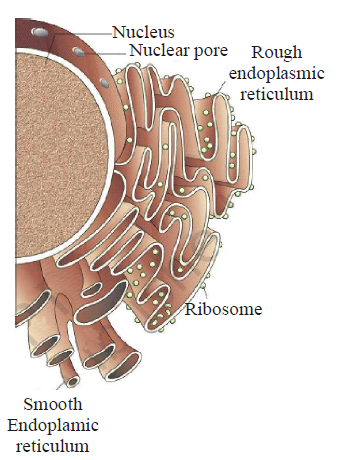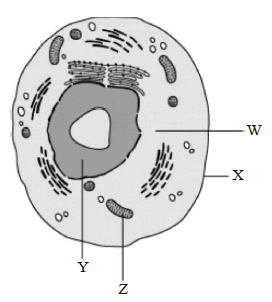The cytoskeleton is a proteinaceous network of fibres in the cytoplasm. It is involved in
mechanical support.
motility.
maintenace of cell-shape.
all of the above
Correct Answer :
D. all of the above
The cytoskeleton is a series of intercellular proteins that help a cell with shape, mechanical support, and movement. Cytoskeleton has three main structural components: microfilaments, intermediate filaments, and microtubules.
Related Questions
Which one of the following cellular parts is correctly matched with their characters ?
Centrioles Sites for active RNA synthesis.
Lysosomes Optimally active at a pH of about 8.5.
Thylakoids Flattened membranous sacs forming the grana of chloroplasts.
Ribosomes Those on chloroplasts are larger (80S) while those in the cytoplasm are smaller (70S).
Match column-I with column-II and select the correct option.
| Column - I | Column - II |
|---|---|
| A. RER | I. Intracellular and extracellular digestion |
| B. Cell wall | II. Provide structural support to the cell |
| C. Flagella | III. Protein synthesis and secretion |
| D. Lysosomes | IV Responsible for cell movement |
A III, B II, C IV, D I
A II, B III, C IV, D I
A I, B III, C II, D IV
A IV, B II, C III, D I
Plastids are found in
all animal cells.
some animal cells.
all plant cells.
all plant cells and euglenoides.
The diagram given below represent a filuid mosaic model of plasma membrance. Match the components marked as A, B, C, D and E in the diagram below from the list (i) to (vii).

- Sugar
- Protein
- Lipid bilayer
- Integral protein
- Cytoplasm
- Cell wall
- External protein
A - (i), B - (ii), C - (iii), D - (iv), E - (v)
A - (ii), B - (i), C - (iii), D - (iv), E - (v)
A - (i), B - (ii), C - (iii), D - (iv), E - (vi)
A - (i), B - (ii), C - (iii), D - (vii), E - (v)
Integral proteins of cell membrane occur on/in
inner surfaces
outer surfaces
phospholipid matrix
inner and outer surfaces
Which of the following statement is correct regarding vacuole?
It is membrane-bound and contains storage proteins and lipids.
It is membrane-bound and contains water and excretory substances.
It lacks membrane and contains air.
It lacks membrane and contains water and excretory substances.
The following diagram shows some of the missing structures in a plant cell marked as A, B, C, D E. Choose the option with their correct names.

A - Plasmodesmata, B - Rough endoplasmic reticulum, C - Golgi apparatus, D - Mitochondrion, E - Ribosomes
A - Desmosome, B - Rough endoplasmic reticulum, C - Golgi apparatus, D - Mitochondrion, E - Ribosomes
A - Plasmodesmata, B - Smooth endoplasmic reticulum, C - Golgi apparatus, D - Mitochondrion, E - Ribosomes
A - Tight junction, B - Rough endoplasmic reticulum, C - Golgi apparatus, D - Mitochondrion, E -Ribosomes
Which of the following terms is not correctly matched with its feature?
Osmosis Movement of water by diffusion.
Nucleoplasm Site of active synthesis of ribosomal RNA.
Mesosome Infolding of cell membrane and characteristics of eukaryotes.
Pili Elongated tubular surface structures (made of special protein) of bacteria.
Match column-I with column-II and choose the correct option.
| Column-I | Column-II |
|---|---|
| A. Tonoplast | I. Contain digestive enzyme |
| B. Contractile vacuole | II. Store metabolic gases |
| C. Food vacuole | III. Excretion |
| D. Air vacuole | IV. Transport of ions in plants |
A IV; B III; C I; D II
A II; B III; C IV; D I
A IV; B II; C III; D I
A I; B III; C II; D IV
The given diagram shows the types of chromosomes (labelled as A, B, C & D) based on the position of centromere.
Which one is the correct option for the labelled chromosomes. A, B, C and D ?

A Telocentric chromosome, B Acrocentric chromosome, C Submetacentric chromosome, D Metacentric chromosome
A Acrocentric chromosome, B Telocentric chromosome, C Metacentric chromosome, D Submetacentric chromosome
A Submetacentric chromosome, B Metacentric chromosome, C Telocentric chromosome, D Acrocentric chromosome
A Metacentric chromosome, B Submetacentric chromosome, C Acrocentric chromosome, D Telocentric chromosome.
Function of RER is
autolysis
protein synthesis
lipid synthesis
carbohydrate synthesis
Which of the following will determines the shape of the cells and provides a strong structural support to prevent the bacterium from bursting or collapsing?
Plasmids
Cell wall
Mesosome
Cell membrane
The figure below shows the structure of a mitochondrion with its four parts labelled (A), (B), (C) and (D).

Select the part correctly matched with its function.
Part (D): Outer membrane Gives rise to inner membrane by splitting.
Part (B): Inner membrane Forms infoldings called cristae.
Part (C): Cristae Possess single circular DNA molecule and ribosomes.
Part (A): Matrix Major site for respiratory chain enzymes.
Nucleolus is
rounded structure found in cytoplasm near nucleus.
rounded structure inside nucleus and having rRNA.
rod-shaped structure in cytoplasm near the nucleus.
none of the above.
Which of the following lacks cell wall?
Gametes
Amoeba
Mycoplasma
All of these
Select the statements which are related to Schwann.
- He reported that cells have a thin outer layer which is today known as plasma membrane
- Cell wall is a unique character of the plant cell.
- Body of plants and animals are composed of cells and products of cells.
Only (i)
Only (iii)
(i) and (iii)
All of these
Select the incorrect statement about prokaryotic ribosomes.
50S and 30S subunits unite to form 70S ribosomes.
Polysome/polyribosome consists of many ribosomes only.
Ribosome is the site of protein synthesis.
Polysome indicate the synthesis of identical poolypeptide in multiple copies.
Which one of the following organelle given below is correctly matched with its function ?

Golgi apparatus Protein synthesis
Golgi apparatus Formation of glycolipids
Rough endoplasmic reticulum Protein synthesis
Rough endoplasmic reticulum Formation of glycoproteins
Protein synthesis in an animal cell occurs
on ribosomes present in cytoplasm as well as in mitochondria.
on ribosomes present in the nucleolus as well as in cytoplasm.
only on ribosomes attached to the nuclears envelope and endoplasmic reticulum.
only on the ribosomes present in cytosol.
The cytoskeleton is a proteinaceous network of fibres in the cytoplasm. It is involved in
mechanical support.
motility.
maintenace of cell-shape.
all of the above
Who proposed the theory that Cells arise only from the pre-existing cells?
Mohl
Virchow
Haeckel
Brown
The main organelle involved in modification and routing of newly synthesized proteins to their destinations is
chloroplast
mitochondria
lysosome
endoplasmic reticulum

Which function is carried out by the cell organelle 'X'?
helps control the movement of substance in and out of the cell
passes information from the parent cell to newly formed cell
maintains the proper shape of the cell and serves as a protective barrier
helps the cell to make food with the help of chlorophyll and sunlight
Which of the following is incorrect ?
Mycoplasma is the smallest cell (0.3 �).
Bacteria are 3 to 5 �m in size.
The largest cell is the egg of an ostrich.
Nerve cells are some of the smallest cells.
Active transport differs from passive transport in that active transport
requires energy.
always requires input of ATP.
moves molecules against a concentration gradient.
both (a) and (c)
Which of these is wrongly matched?
Chloroplasts Chlorophyll
Elaioplasts Starch
Chromoplasts Carotenoids
Amyloplasts Carbohydrates
Which of the following statements are incorrect ?
- Plant cells have centrioles which are absent in almost all animal cells.
- Ribosomes are the site of protein synthesis.
- The middle lamella is a layer mainly of calcium carbonate which holds the different neighbouring cells together.
- In animal cell, steroidal hormones are synthesized by smooth endoplasmic reticulum. Of the above statements
(i) and (iii)
(iii) and (iv)
(ii) and (iv)
(i) and (iv)
Which of the following statements is/are correct ?
- The endomembrane system includes plasma membrane, ER, Golgi complex, lysosomes and vacuoles.
- ER helps in the transport of substances, synthesis of proteins, lipoproteins and glycogen.
- Ribosomes are involved in protein synthesis.
- Mitochondria help in oxidative phosphorylation and generation of ATP.
(ii), (iii) & (iv)
(i) only
(ii) only
(iii) only
A component of cytoskeleton is
microtubule
bone
chitin
cartilage.
Which of the following statements is/are correct ?
- The shape of the cells may vary with the function they perform.
- Human RBC is about 7.0 ??m in diameter.
- Cytoplasm is the main area of cellular activities.
- Various chemical reactions occur in cytoplasm to keep the cell in the living state.
(i), (ii), (iii) and (iv)
Only (i) and (ii)
Only (iv)
None of the above
